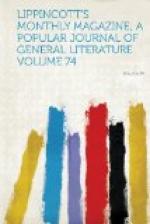The nations comfortably installed, we must sketch the tactical system under which they are drawn up for peaceful contest. The classification of subjects adopted by the Commission embraces seven departments. Of these, the Main Building is devoted to I. Mining and Metallurgy; II. Manufactures; III. Education and Science; Memorial Hall and its appendages, to IV. Art; Machinery Hall, to V. Machinery; Agricultural Hall, to VI. Agriculture; and Horticultural Hall and its parterres, to VII. Horticulture. These habitats have, as we have heretofore seen, proved too contracted for the august and expansive inmates assigned them. All of the latter have overflowed; mining, for instance, into the mineral annex of thirty-two thousand square feet and the great pavilion (a hundred and thirty-five feet square) of Colorado and Kansas; education into the Swedish and Pennsylvania school-houses and others already noted; manufactures into breweries, glass-houses, etc.; and so on with an infinity of irrepressible outgrowths.
[Illustration: FACADE OF THE DIVISION OF THE NETHERLANDS, MAIN BUILDING.]
Department I. is subdivided into classes numbered from 100 to 129, and embracing the products of mines and the means of extracting and reducing them. II. extends from Class 200 to Class 296—chemical manufactures, ceramics, furniture, woven goods of all kinds, jewelry, paper, stationery, weapons, medical appliances, hardware, vehicles and their accessories. III. deals with the high province of educational systems, methods and libraries; institutions and organizations; scientific and philosophical instruments and methods; engineering, architecture in its technical and non-aesthetic aspect, maps; physical, moral and social condition of man. Fifty classes, 300 to 349 inclusive, fence in this field of pure reason. Department IV., Classes 400-459, covers sculpture, painting, photography, engraving and lithography, industrial and architectural designs, ceramic decorations, mosaics, etc. V., Classes 509-599, takes charge of machines and tools for mining, chemistry, weaving, sewing, printing, working metal, wood and stone; motors; hydraulic and pneumatic apparatus; railway stock or “plant;” machinery for preparing agricultural products; “aerial, pneumatic and water transportation,” and “machinery and apparatus especially adapted to the requirements of the exhibition.” VI., Classes 600-699, assembles arboriculture and forest products, pomology, agricultural products, land and marine animals, pisciculture and its apparatus, “animal and vegetable products,” textile substances, machines, implements and products of manufacture, agricultural engineering and administration, tillage and general management. Under Department VII., Classes 700-739, come ornamental trees, shrubs and flowers, hothouses and conservatories, garden tools and contrivances, garden designing, construction and management.




